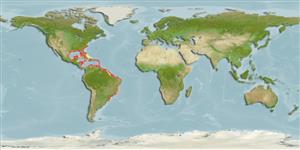Teleostei (teleosts) >
Mulliformes (Goatfishes) >
Mullidae (Goatfishes)
Etymology: Upeneus: Greek, ypene, -es = upper lip (Ref. 45335).
More on author: Poey.
Environment: milieu / climate zone / depth range / distribution range
Ecology
Marine; demersal; depth range 18 - 100 m (Ref. 5217), usually 40 - 70 m (Ref. 9626). Tropical; 37°N - 33°S, 98°W - 34°W
Western Atlantic: North Carolina, USA and Puerto Rico to Santa Catarina, Brazil (Ref. 57756). Absent in the Bahamas, Bermuda, and the western Caribbean (Ref. 26938).
Length at first maturity / Size / Weight / Age
Maturity: Lm 14.6 range ? - ? cm
Max length : 30.0 cm TL male/unsexed; (Ref. 26938); common length : 20.0 cm TL male/unsexed; (Ref. 3792); max. published weight: 180.00 g (Ref. 126891)
Found over mud and sand bottoms (Ref. 3792). Juveniles up to 8 cm are pelagic (Ref. 9626). Feeds mainly on benthic invertebrates (Ref. 3792). Flesh considered good quality; marketed fresh and frozen (Ref. 3792). In southwestern Brazil found in 112 m depth (Ref. 47377).
Life cycle and mating behavior
Maturity | Reproduction | Spawning | Eggs | Fecundity | Larvae
Robins, C.R. and G.C. Ray, 1986. A field guide to Atlantic coast fishes of North America. Houghton Mifflin Company, Boston, U.S.A. 354 p. (Ref. 7251)
IUCN Red List Status (Ref. 130435: Version 2024-2)
Threat to humans
Harmless
Human uses
Fisheries: commercial
Tools
Special reports
Download XML
Internet sources
Estimates based on models
Preferred temperature (Ref.
123201): 19.5 - 27.3, mean 24.5 °C (based on 127 cells).
Phylogenetic diversity index (Ref.
82804): PD
50 = 0.5000 [Uniqueness, from 0.5 = low to 2.0 = high].
Bayesian length-weight: a=0.00955 (0.00804 - 0.01134), b=3.11 (3.08 - 3.14), in cm total length, based on LWR estimates for this species (Ref.
93245).
Trophic level (Ref.
69278): 3.9 ±0.7 se; based on diet studies.
Generation time: 3.1 ( na - na) years. Estimated as median ln(3)/K based on 1
growth studies.
Resilience (Ref.
120179): Medium, minimum population doubling time 1.4 - 4.4 years (Preliminary K or Fecundity.).
Fishing Vulnerability (Ref.
59153): Low to moderate vulnerability (31 of 100).
Nutrients (Ref.
124155): Calcium = 157 [89, 302] mg/100g; Iron = 1 [0, 2] mg/100g; Protein = 17.4 [15.4, 19.7] %; Omega3 = 0.291 [0.165, 0.535] g/100g; Selenium = 53.4 [28.0, 103.4] μg/100g; VitaminA = 27 [9, 94] μg/100g; Zinc = 1.07 [0.66, 1.52] mg/100g (wet weight); based on
nutrient studies.
